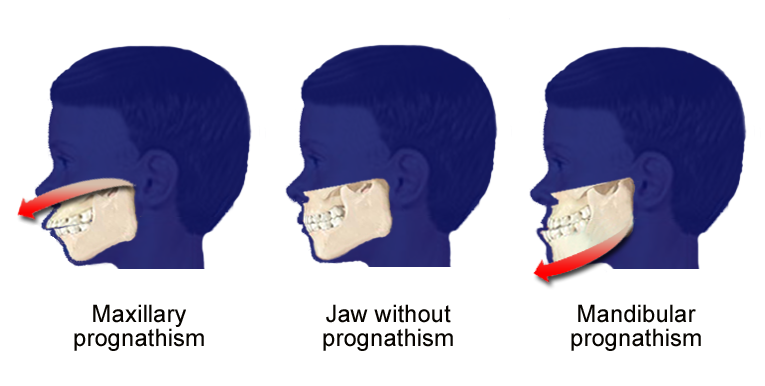What are the symptoms of prognathism?
Prognathism is a condition characterized by the protrusion of the jaw, particularly the lower jaw (mandible) or upper jaw (maxilla). Symptoms of prognathism can vary depending on the severity and whether it affects the upper jaw, lower jaw, or both. Common symptoms include:
- Prominent Jaw: A noticeable protrusion of the lower or upper jaw, causing an extended chin or forward-positioned jaw.
- Misaligned Teeth: Malocclusion, or improper alignment of the teeth, leading to bite problems such as an underbite (when the lower teeth overlap the upper teeth) or overbite (when the upper teeth overlap the lower teeth).
- Difficulty Chewing: Problems with chewing or biting food due to misalignment of the teeth and jaws.
- Speech Issues: Speech difficulties or impediments caused by the abnormal positioning of the jaws and teeth.
- Facial Asymmetry: An imbalance or asymmetry in the facial features due to the prominence of the jaw.
- Jaw Pain or Discomfort: Pain or discomfort in the jaw joint (temporomandibular joint) and muscles due to the strain caused by the misalignment.
- Breathing Difficulties: In severe cases, prognathism can contribute to breathing difficulties or sleep apnea due to airway obstruction.
Prognathism can be a result of genetic factors, certain medical conditions, or developmental issues. Treatment options may include orthodontic treatments, dental appliances, or surgical interventions to correct the jaw alignment and improve function and appearance.
What are the causes of prognathism?
Prognathism, characterized by the protrusion of the upper or lower jaw, can be caused by a variety of genetic, developmental, and medical factors. Some common causes include:
- Genetics: Inherited traits from parents can play a significant role in the development of prognathism. If one or both parents have a prominent jaw, there is a higher likelihood that their children will also have this feature.
- Growth Disorders: Conditions such as acromegaly, which involves the excessive production of growth hormone, can lead to abnormal growth of the jaw and other bones.
- Congenital Conditions: Certain congenital syndromes, such as Crouzon syndrome, Down syndrome, and Treacher Collins syndrome, can be associated with prognathism.
- Dental Issues: Improper alignment of teeth, such as underbites or overbites, can contribute to the development of prognathism. This can result from habits like thumb-sucking or prolonged use of a pacifier in childhood.
- Developmental Factors: Discrepancies in the growth rates of the upper and lower jaws during development can lead to prognathism. For example, if the lower jaw grows more rapidly than the upper jaw, it can result in a prominent lower jaw.
- Environmental Factors: Certain environmental influences during growth and development, such as nutrition and overall health, can impact jaw development.
- Endocrine Disorders: Hormonal imbalances, such as those seen in gigantism or pituitary disorders, can affect the growth and development of the jaw.
Each case of prognathism can be unique, and determining the specific cause often requires a thorough evaluation by healthcare professionals, including genetic testing and detailed medical history analysis.
What is the treatment for prognathism?
Treatment for prognathism depends on the severity of the condition, the underlying cause, and the impact on function and appearance. Here are the common approaches to treating prognathism:
Orthodontic Treatment: Braces and other orthodontic devices can help realign the teeth and jaws. This is often the first line of treatment, especially in growing children and adolescents, to correct bite issues and improve jaw alignment.
Dental Appliances: Devices such as retainers, headgear, or other orthodontic appliances may be used to gradually reposition the jaw and teeth.
Surgery: In severe cases, orthognathic surgery (jaw surgery) may be required. This involves repositioning the jawbones to achieve proper alignment and improve facial symmetry. Surgery is typically considered when orthodontic treatments alone are insufficient or when the patient has finished growing.
Growth Modulation: In growing children, orthopedic appliances may be used to influence jaw growth direction and size, preventing the development of severe prognathism.
Speech Therapy: If prognathism affects speech, speech therapy may be recommended to help improve articulation and communication skills.
Pain Management: For those experiencing pain or discomfort in the jaw joint (temporomandibular joint), treatments may include pain relief medications, physical therapy, or other interventions to manage symptoms.
Monitoring and Regular Check-ups: Continuous monitoring by dental and medical professionals is essential to assess the progress of treatment and make necessary adjustments.
A multidisciplinary approach, involving orthodontists, oral surgeons, speech therapists, and other specialists, is often required to achieve the best outcomes for patients with prognathism.

Leave a Reply
You must be logged in to post a comment.